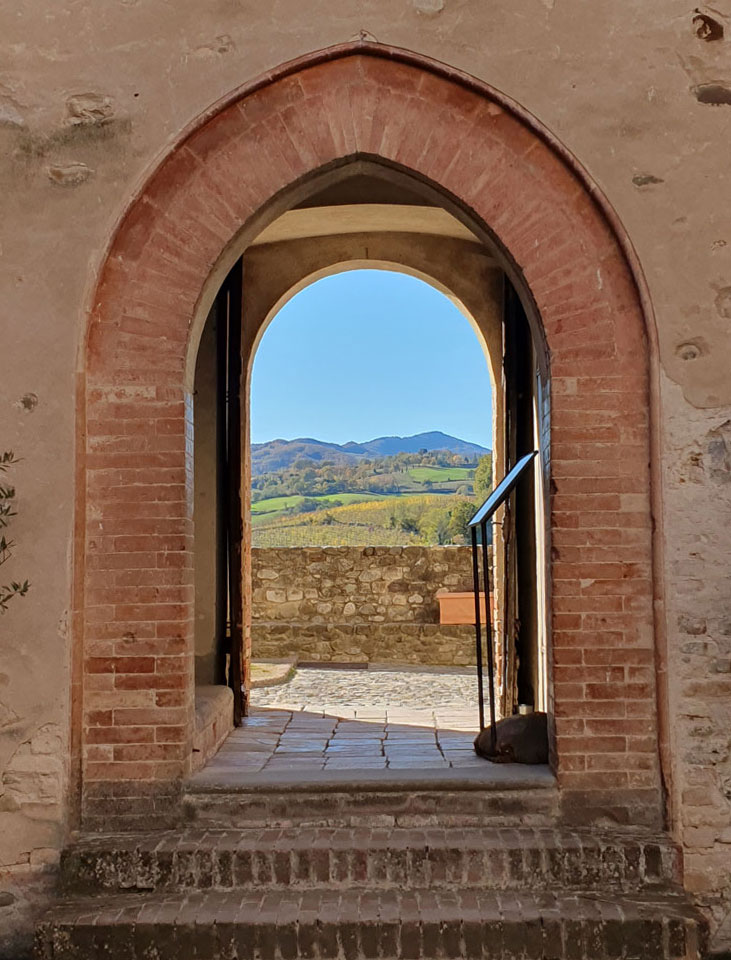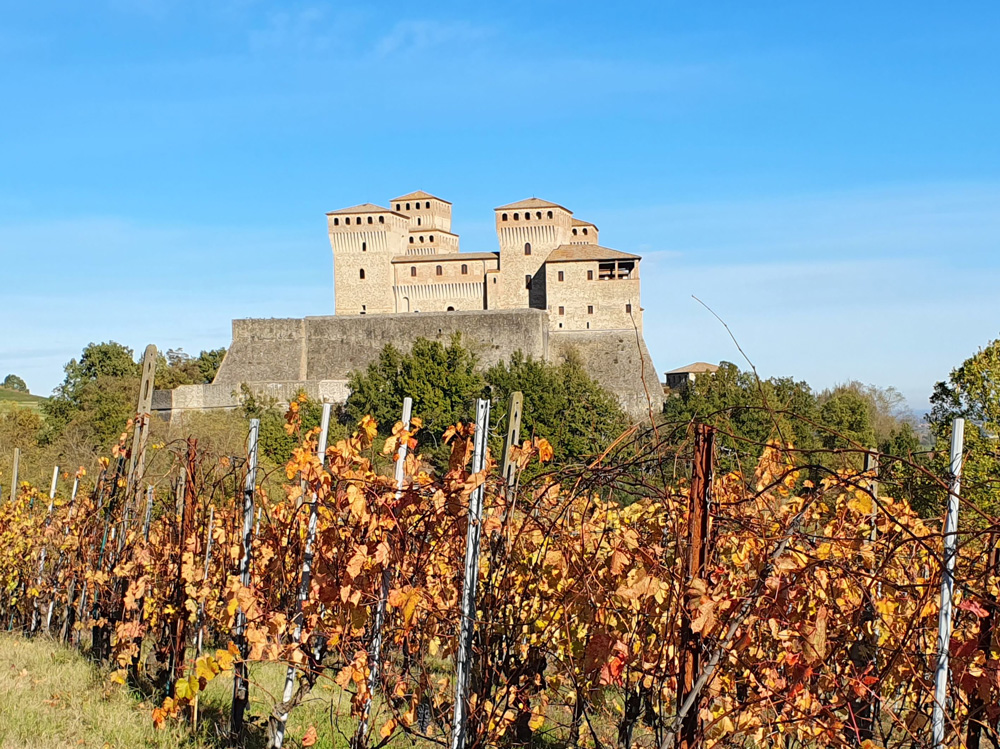The Castello di Torrechiara (Torrechiara castle) is a great introduction to the fortresses of this part of Italy. Just twelve miles south of Parma, it’s easy to reach, attractive and open to the public. The castle also has a compelling story of courtly love attached to its colourful painted chambers.
The north Italian region of Emilia-Romagna is famed for its castles: on hilltops, overlooking rivers, protecting villages and demonstrating the wealth and power of their long-ago lords. Today some are tourist attractions, some are ruinous and some restored, some house hotels or restaurants, some are elegant, some intimidating, some are still home to precious frescoes and others are private residences.
If you can only visit one of the castles of the region, the Castello di Torrechiara is among the best options, well worth a visit for its history, its setting, its frescoes and for the chance to get into the countryside. And it has the great advantage of being reachable by bus from Parma, so is a very convenient day trip destination for car-free travelers.
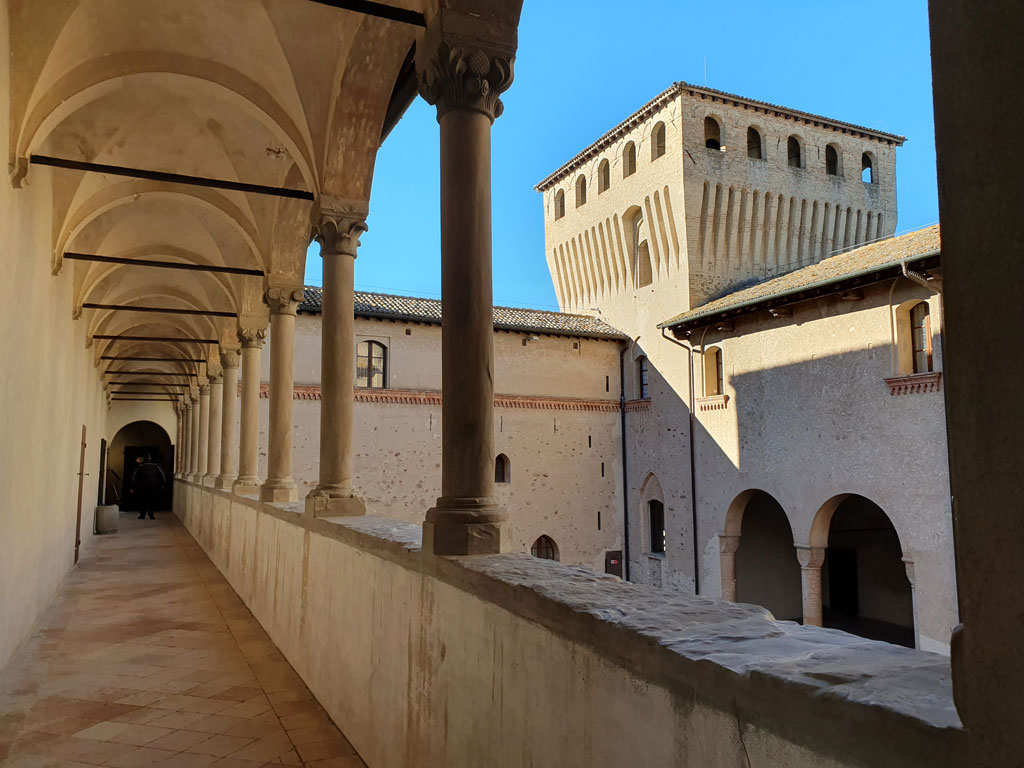
Castle history and legend
The Castello di Torrechiara was built in the middle of the 15th century by Pier Maria Rossi (1413-1482), a condottiere known as Il Magnifico (the Magnificent). As well as a military captain and ambassador he seems to have been an impressive figure with wide-ranging interests including astronomy. The romantic story is that the castle was not only a military stronghold but also a home where he would spend time with his mistress Bianca Pellegrini, its walls decorated with frescoes to celebrate their love. While romantic tales make good marketing and I’d usually take them with a pinch of salt, the scenes of courtly love painted on the walls of the castle’s ‘Golden Chamber’ are very real as well as beautiful.
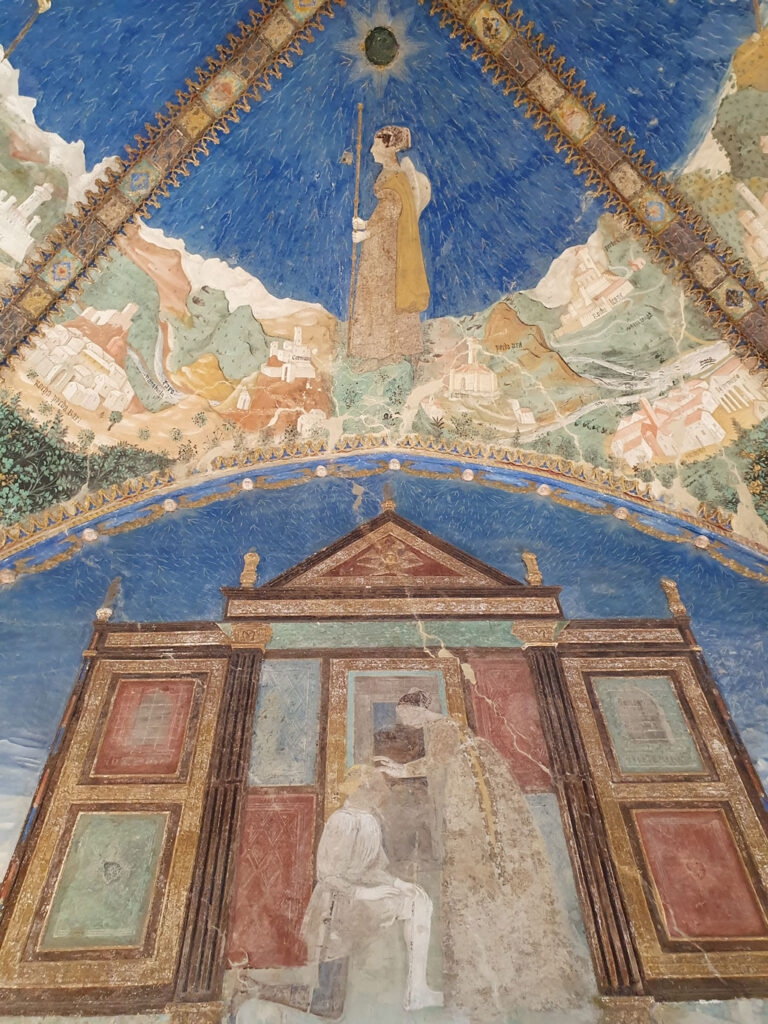
Constructed in a strategic defensive position, the fortress is on a hill at the edge of the plain, commanding views over the Parma river and the surrounding landscape. A tiny picturesque hamlet nestles against the castle walls, and a more modern settlement is located on the level land below, where the road runs north towards Parma.
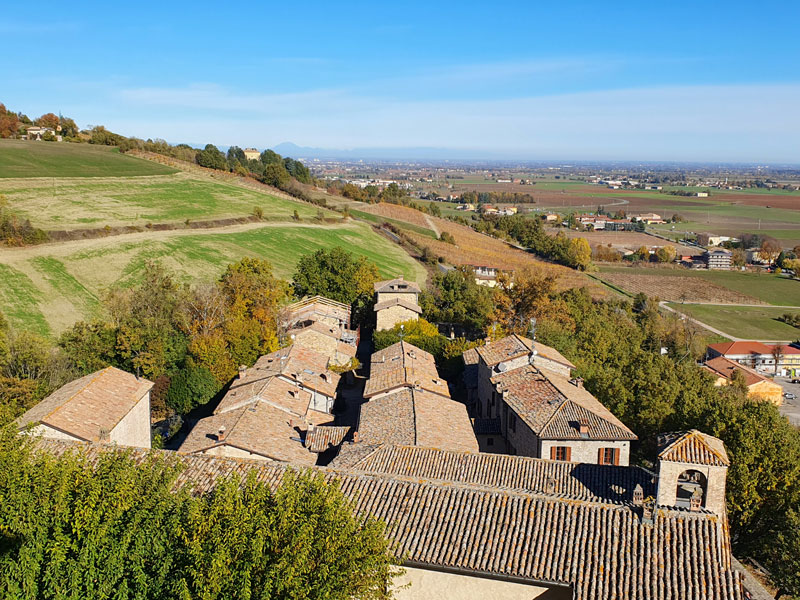
The castle’s entrance and ticket office are at the foot of a long covered ramp which climbs into the heavily-defended fortress. Inside, around a courtyard, a series of halls and smaller rooms over two floors are decorated with wall-paintings from different periods of the building’s history.
The most beautiful of the frescoed rooms is the famous Golden Chamber, the Camera d’Oro. The room was once heavily decorated in gold leaf; leading to its name. Here the romance between Pier Maria Rossi and Bianca Pellegrini is celebrated – along with the many castles held by the family. Torrechiara itself is among the fortresses depicted, labelled with an earlier version of its name, Torciara.
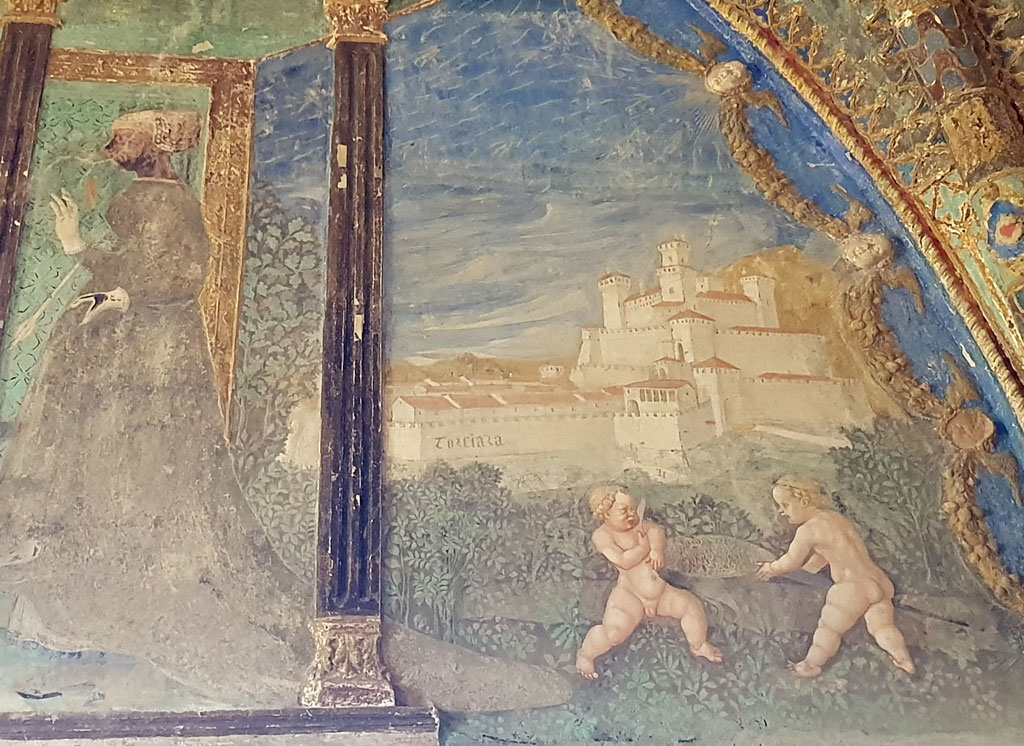
On each wall the two lovers are painted in scenes of stylised romance and chivalry: falling in love thanks to Cupid’s arrow, exchanging tokens of love, and the noble warrior kneeling before his lady. On the ceiling Bianca is depicted as a pilgrim (her surname means ‘pilgrims’) on a pilgrimage of love travelling between castles on a quest to find her beloved – while also showing off their vast domains. The paintings date to 1460-1463, and are attributed to Benedetto Bembo (or possibly his brother Gerolamo). Terracotta tiles on the walls bear emblems including the lovers’ coats of arms.
Two outdoor covered terraces are idyllic panoramic spaces where it’s easy to imagine the courtly scenes that took place here over the centuries. Other frescoed rooms, dating to later eras, include grotesques and jugglers, scenes of the dawn, of birds, of beasts, of fantastical castles and mythological characters including Diana and Actaeon.
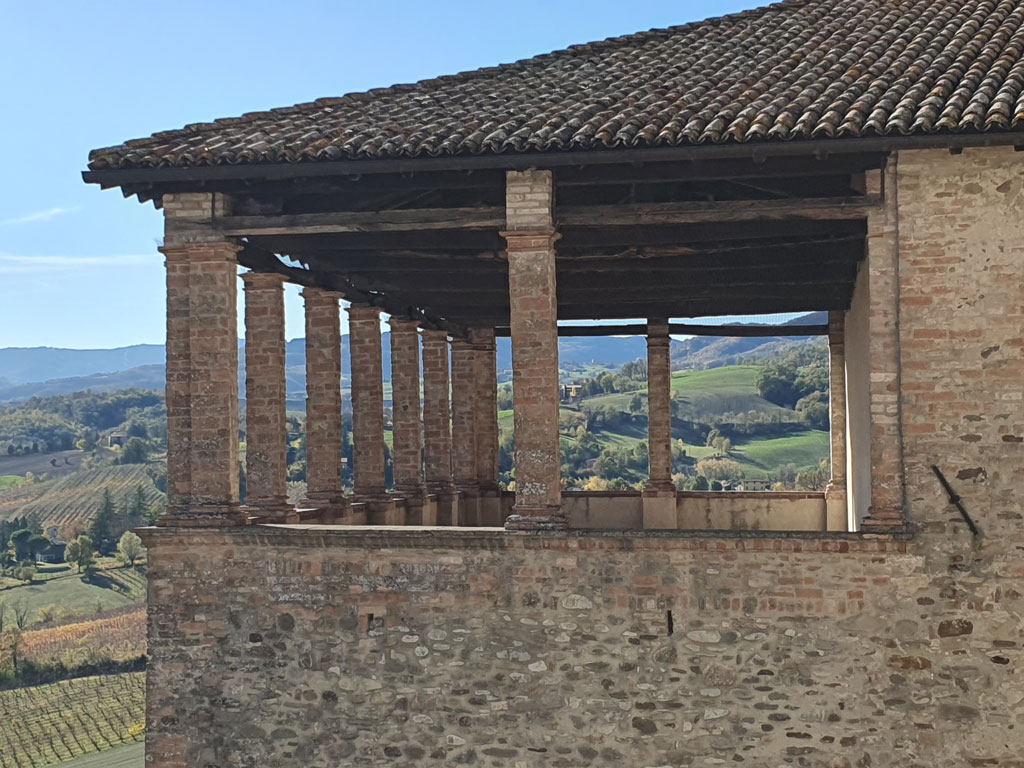
Practicalities and when to visit
Opening times for the castle vary throughout the year, so check before you travel. At the time of writing the castle is open year-round, but closed on Mondays, like most tourist attractions in Italy. Although the castle’s interiors can be enjoyed even on rainy days, a fine day will allow for enjoyment of the countryside and walking opportunities. I visited in November, when the autumn colours were vivid; green springtime would be another scenic time to visit.
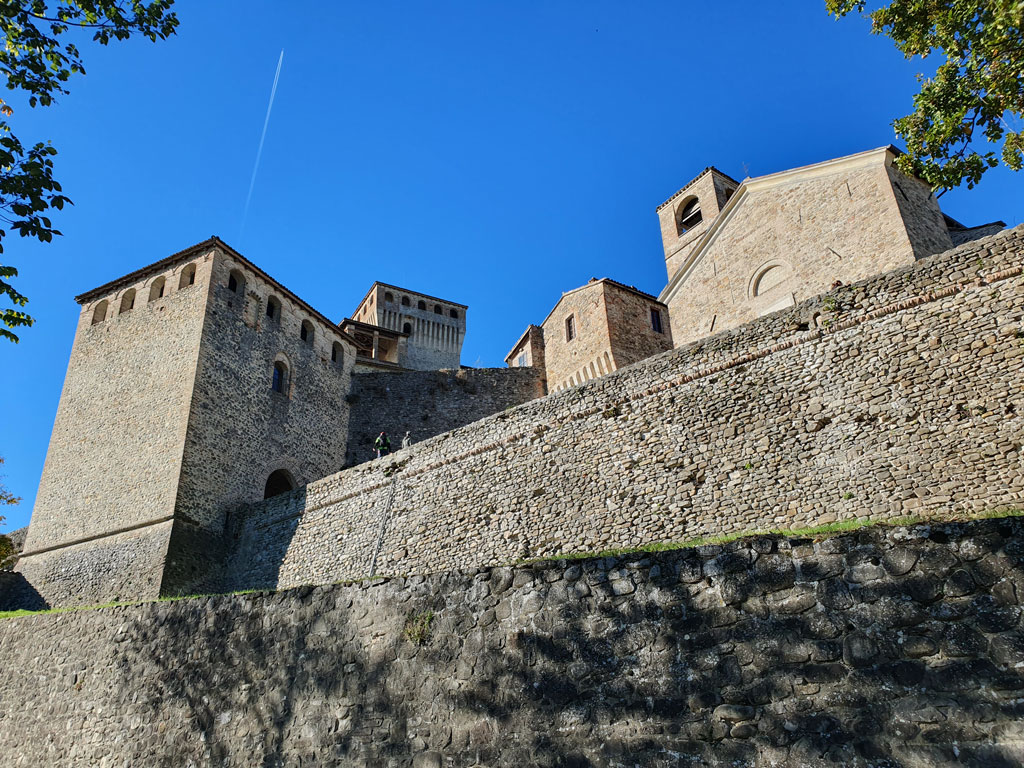
When I visited, the spaces open to the public included the stables, courtyard and upper level with frescoed rooms and terraces. Look out for tours and events offering extra access, for example to the defensive walls.
There’s a tourist information office in the hamlet outside the castle, where you can find useful information, walk leaflets, bus times and advice.
The hamlet by the castle and the village square below offer a small choice of places to eat and drink, with outdoor tables. The Taverna del Castello has the advantage of a terrace with views, and is an atmospheric option.
- Official website for castles of the former Duchy of Parma and Piacenza: Castelli del Ducato
- Torrechiara/Langhirano tourist information: Portale Torrechiara
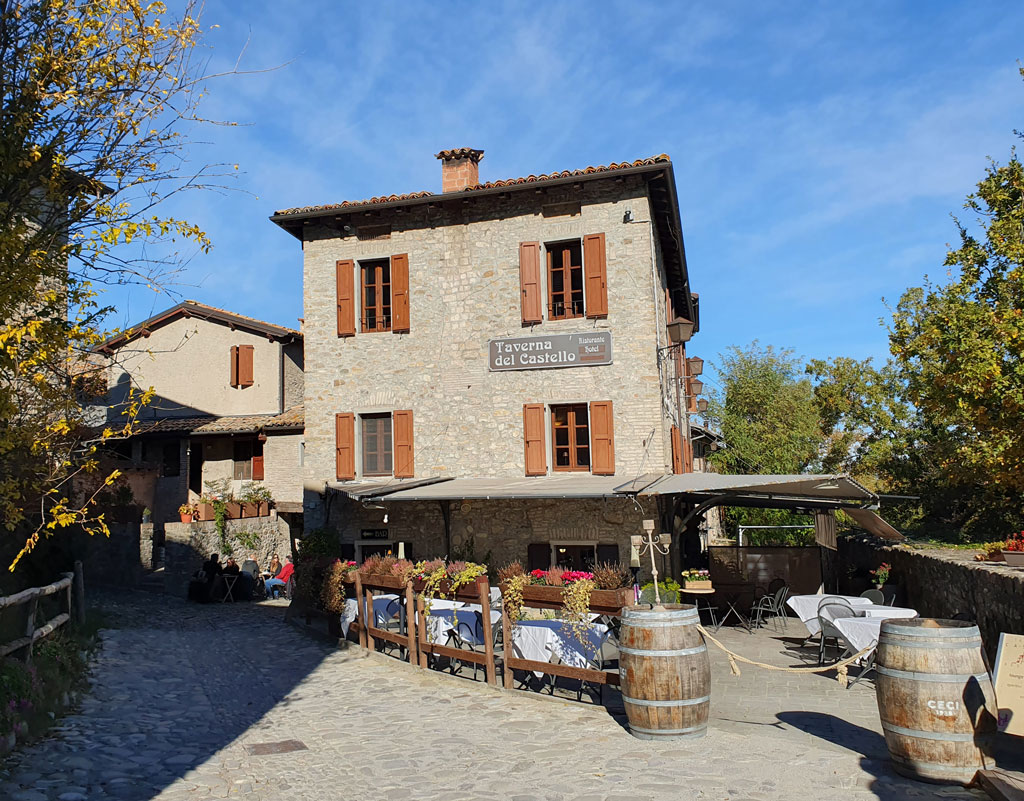
Walking through vineyards and art: the Sentiero d’Arte
If, like me, you love a chance to get out into the countryside, you’ll appreciate the excellent footpath starting at the castle. The Sentiero d’Arte (Art Trail) is a signposted and promoted walking route connecting Torrechiara with Langhirano, a small town to the south. Famed for its prosciutto, and with a museum dedicated to Parma ham, Langhirano is on the same bus route from Parma as Torrechiara, making it fairly straightforward to fit a nature hike around public transport.
The route is around 4 miles long, and decorated along the way with contemporary artworks, adding to the magic of the walk. Some stretches of the route are along roads, others, like this stretch from Torrechiara, along footpaths. A different branch connects Torrechiara with a nearby abbey – read on for more on this further down the page. (Note: I haven’t walked or measured the full route myself, so can’t guarantee timings or distance).
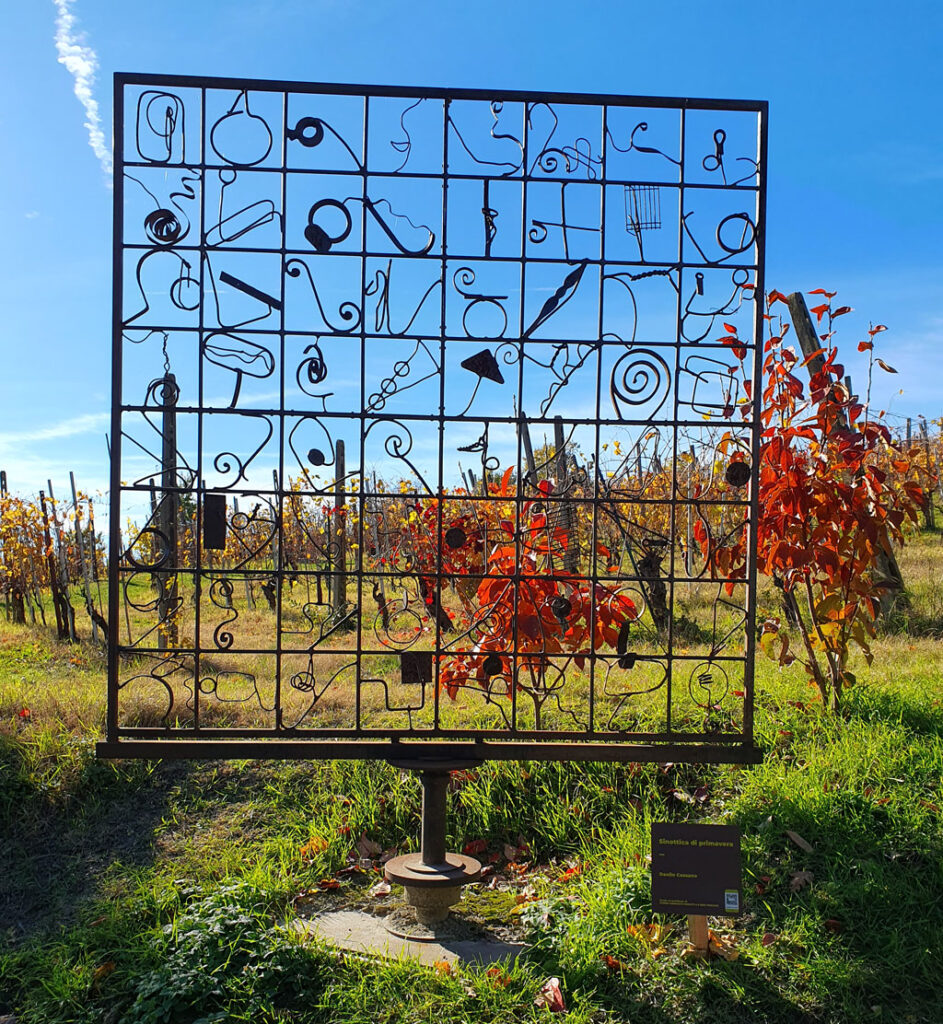
Leaving the Castello di Torrechiara, turn right outside the main gateway, and walk along the outside of the wall. When you reach a footpath sign, take the left-hand branch and then just follow the pathway and the Sentiero d’Arte signs. (A right-hand branch here heads back along the wooded slope on the other side of the castle and joins Strada del Castello by the car park at the junction; I took this route on my return towards the bus stop.)
The path crosses vineyards, contouring, dropping and rising again. There are fantastic photo opportunities looking back towards the castle. There are a couple of artworks to admire along this stretch, and a bench beneath a tree.
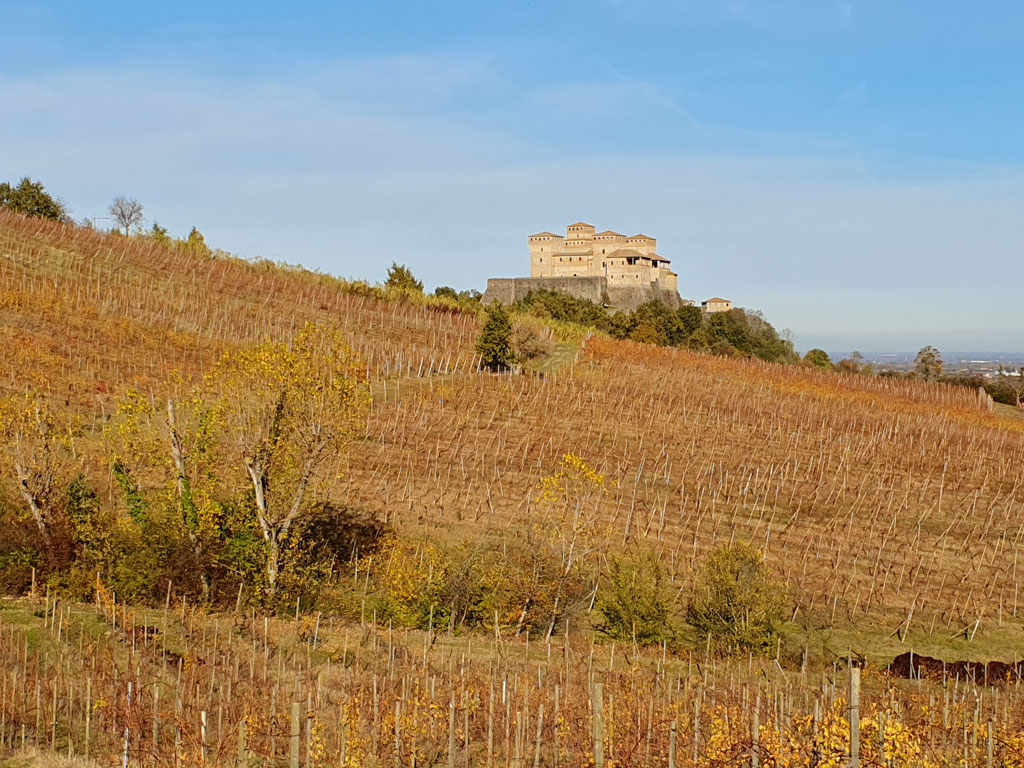
I had a busy day (more below) so only had time for a short stretch of the footpath. I just walked from the castle until I reached the next road and winery, then retraced my steps. The walk was so attractive and the November day so glorious that I was very tempted to continue to Langhirano, and I think a day of castle, lunch and walk would be wonderfully idyllic if you’re a lover of the outdoors. Starting at the castle you could pick up info from the tourist office, set off towards Langhirano then catch a bus back towards Parma via Torrechiara. However, if you are making a full day excursion and planning ahead, it must be wonderfully romantic to start at Langhirano and walk to the castle, arriving on foot across vineyards.
Note that although the section I walked was very gentle and easy, some short stretches would have been muddy after rain. Wear suitable shoes and of course don’t forget sun lotion and drinking water. There’s a useful water tap in the square near the tourist office at Torrechiara.
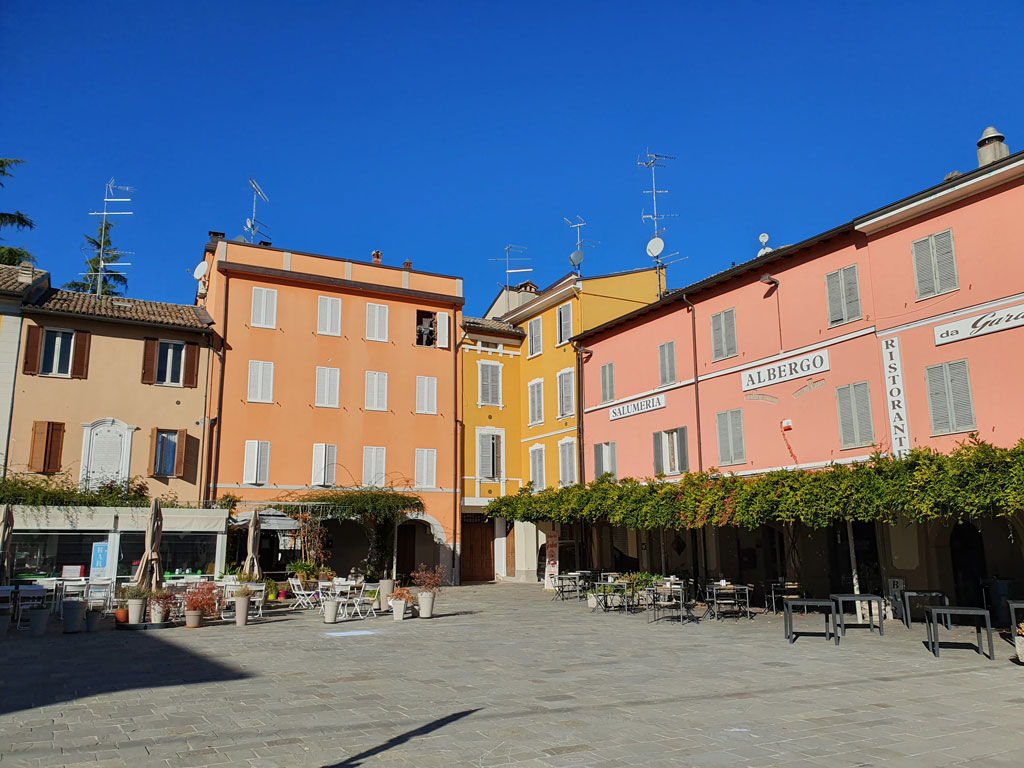
Get to Torrechiara
Car-free travel
The number 12 bus connects Parma with Torrechiara, a journey of around 35 minutes. The bus stop in Torrechiara is within easy walking distance of the Castello: about ten minutes along quiet roads. In Parma the bus has several stops heading south, including the railway station and Piazza Ghiaia. At the time of writing tickets can be bought onboard with a credit card or in advance at a ticket office and some local businesses such as bars.
Check timetables in advance and note that not all 12s take the same route. For Torrechiara you need a service running via Langhirano. When I visited, the bus to Torrechiara was hourly. Bus timetables: TEP Linea 12
The bus stop for the castle is alongside the pretty and colourful village square, Piazza Leoni; the return bus stop is just over the road. There’s a choice of places to eat or drink here; ideal if you have a little time to kill before the next bus.
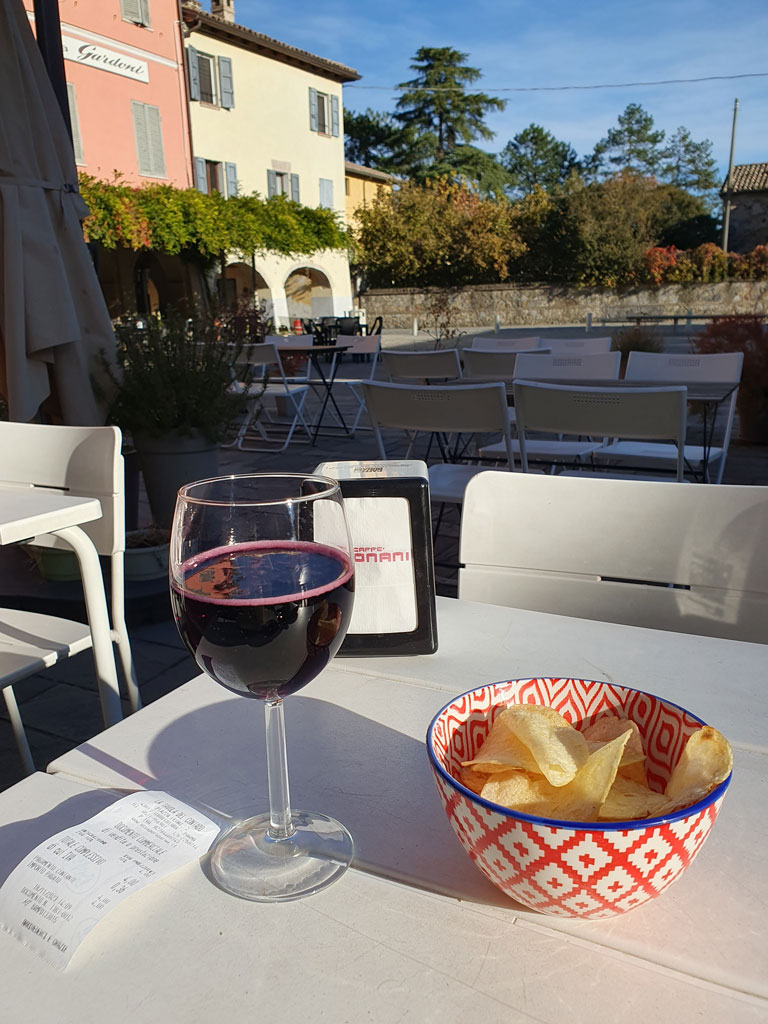
The castle is a short walk away and wayfinding is easy. Just take the road alongside the square, Strada del Mulino, and continue until you take a left turn onto Strada del Castello, which climbs to the castle entrance. Note that alongside the car park by the junction there is a footpath entrance – this leads to the Sentiero d’Arte, and follows the wooded slope around the rear of the castle before joining another path from the castle gateway. You could approach the castle this way, although it is longer and without the views from the road.
This is a pleasant and straightforward day out by public transport, but it does help to plan your day in advance, checking bus times in both directions as well as the castle’s opening times, and working around these. The tourist information office in Parma should be able to advise on the latest times and practicalities.
By car
There are a couple of car parks on the road leading uphill to the castle. The closest of these, after a corner where the road starts climbing uphill, is also convenient for footpath access, and has a children’s playground alongside. You’ll still need to walk the last stretch of road uphill. There may also be space for a few cars to park alongside the walls, but I’d recommend the official car park.
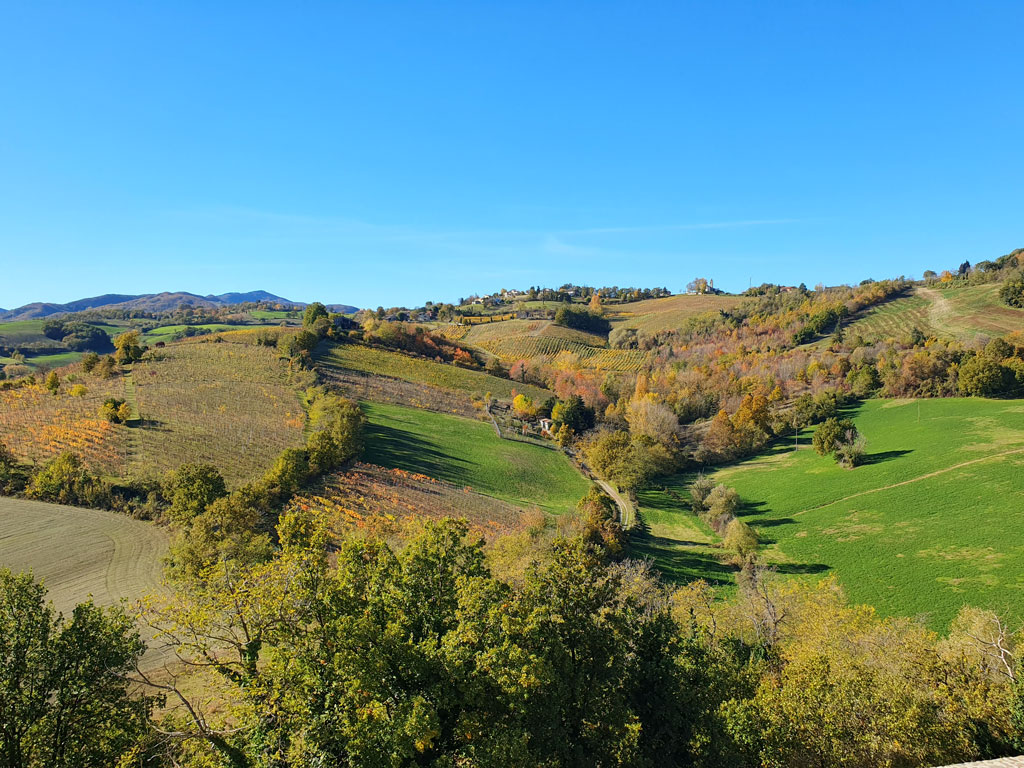
Why and how to visit the Castello di Torrechiara
The castle makes a great car-free day out from Parma, ideal for travellers exploring Italy by public transport. For those with cars, it’s an excellent destination if you’re staying anywhere locally, or for a break on a longer journey.
The castle itself, its history, those glorious frescoes and the views are already good reasons to visit. Most visitors, though, will enjoy including a leisurely lunch into their excursion, and maybe an aperitivo too.
The Sentiero d’Arte offers a fantastic opportunity to get out into the vineyards and enjoy a walk, whether you prefer a scenic stroll with photo-opportunities or a longer hike. With vines, wine-tasting opportunities and art along the way, this is a wonderful taste of the countryside and hills of Emilia-Romagna.
I visited by bus from Parma in gorgous sunny weather in November; autumn had turned the vines picturesquely golden. As I planned around both castle opening times and bus timetables, needing to return to Parma in time to visit several museums, I skipped lunch and chose a short walk instead, eating a protein bar along the way. I did, however, have time to enjoy a quick glass of local red Lambrusco as I waited in the village square near the bus stop. This trip was an absolute highlight of my stay in the area.
Out on the footpath I had a sensation of being connected to the past, and some imprints I saw in the mud brought castle’s love story alive in my imagination – read more in my blog piece: Castle of Love.
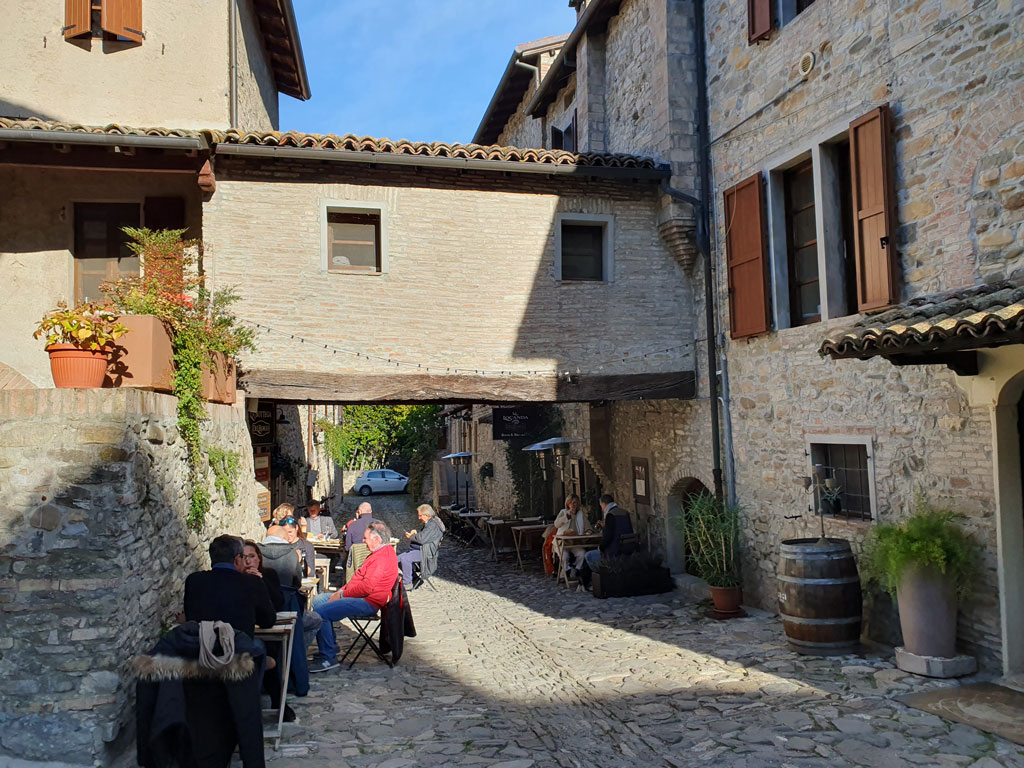
Stay in Torrechiara
The borgo of Torrechiara, the tiny historic hamlet sheltered under the castle’s walls, is very small but would make an atmospheric place to stay overnight. The Locanda del Borgo is in a perfect location for stepping back into history (but with modern comfort). E-bike rental adds to the possibilities for exploring and enjoying the surrounding countryside.
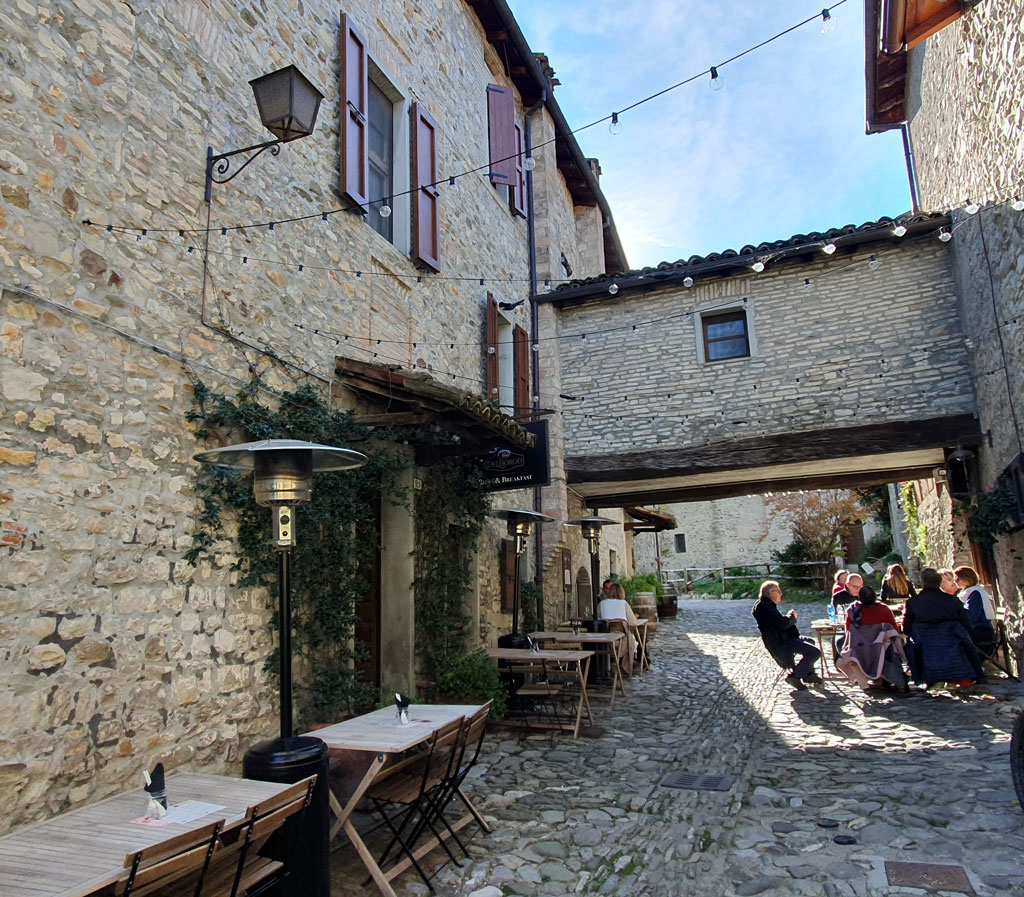
B&B Torrechiara, a mile away in the direction of Parma, offers good, simple accommodation; a convenient base for drivers and cyclists. And over the river close to Torrechiara is Tenuta i Musi Lunghi, a welcoming farmstay B&B.
- Torrechiara accommodation – find other options in the surrounding area, including agriturismi, apartments and villas
- Castles – not so local to Torrechiara, but offering the special experience of staying in a castle: Castello di Vigoleno, Castello di Viano, Antica Corte Pallavicina Relais
Accommodation affiliate links will earn a small commission to support this website, without you paying extra. Thank you for your help.
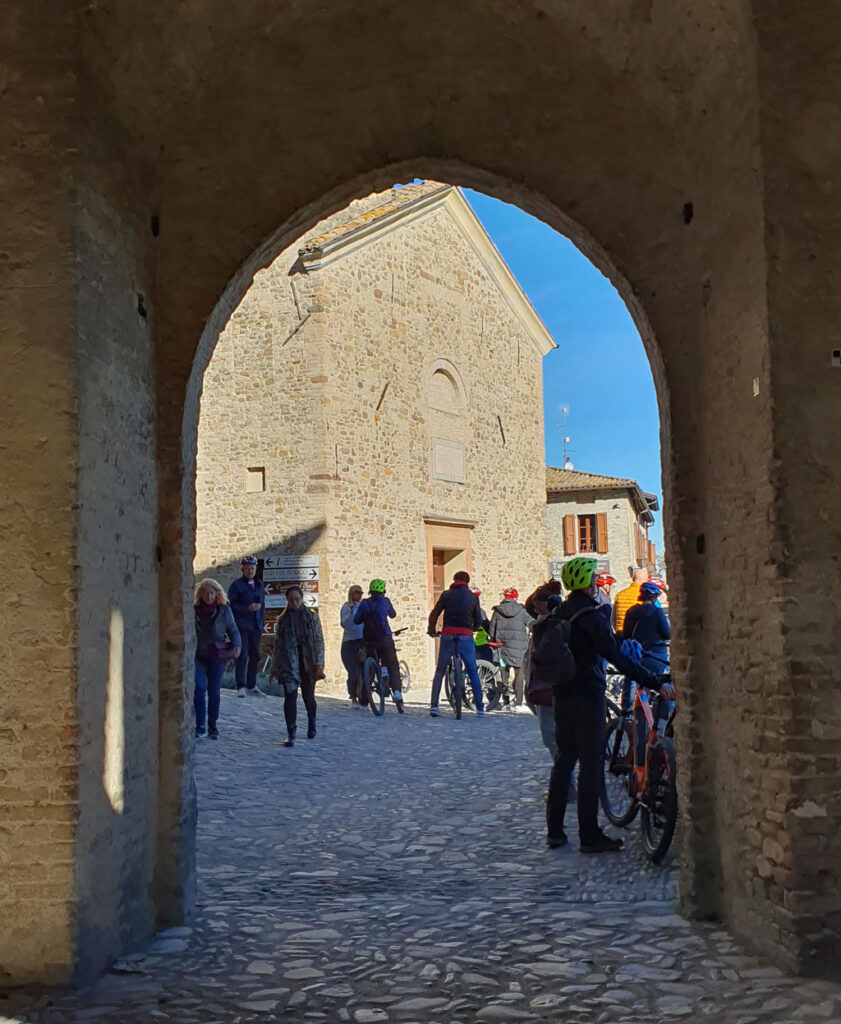
In the area
As well as the already-mentioned Parma ham museum in Langhirano and the scenic Art Trail, there is also a historic Benedictine Abbey nearby, founded in 1471 by Pier Maria Rossi: the Badia di Santa Maria della Neve. Alongside the river Parma, it has a handsome cloister, frescoes and a shop selling traditional herbal and honey products (limited opening hours). A branch of the Sentiero d’Arte, along roads, connects the abbey with the Castello di Torrechiara.
The nearest city is Parma, which is full of attractions from excellent restaurants to art and music museums. Further afield, Reggio Emilia, Modena, Piacenza and Bologna can be combined into a varied and interesting travel itinerary. A less urban option would be to explore the hills and castles of the area by car.
Emilia-Romagna destinations
- Emilia-Romagna region – an introduction
- Bologna
- Castello di Torrechiara
- Ferrara
- Parma
- Ravenna
- Rimini
